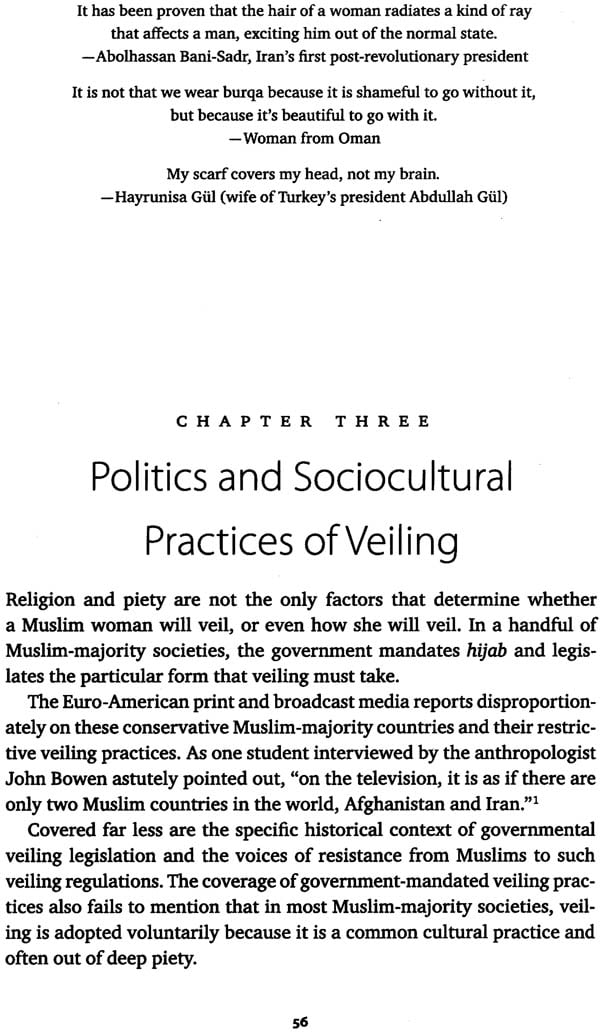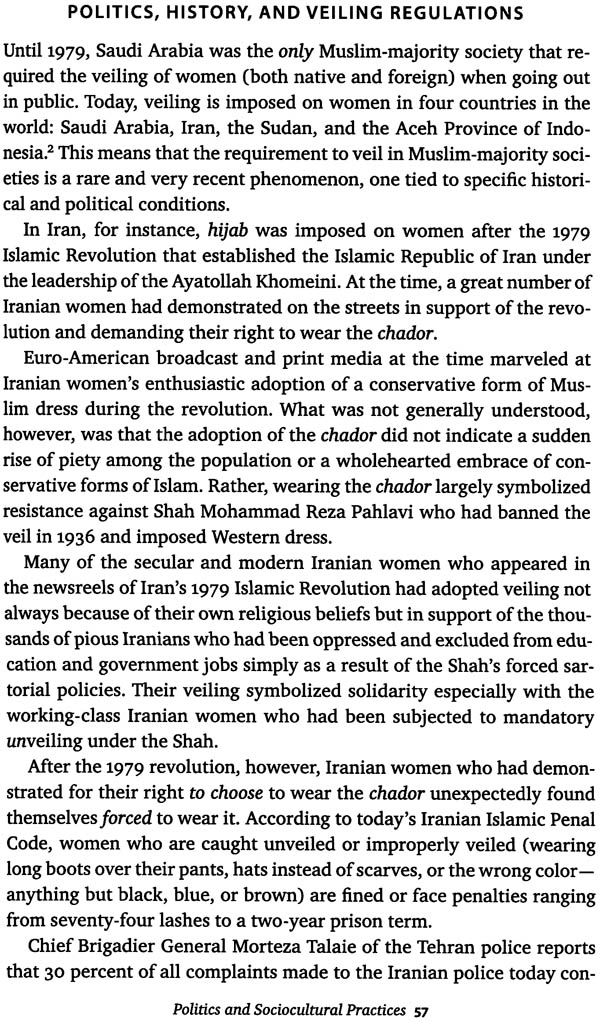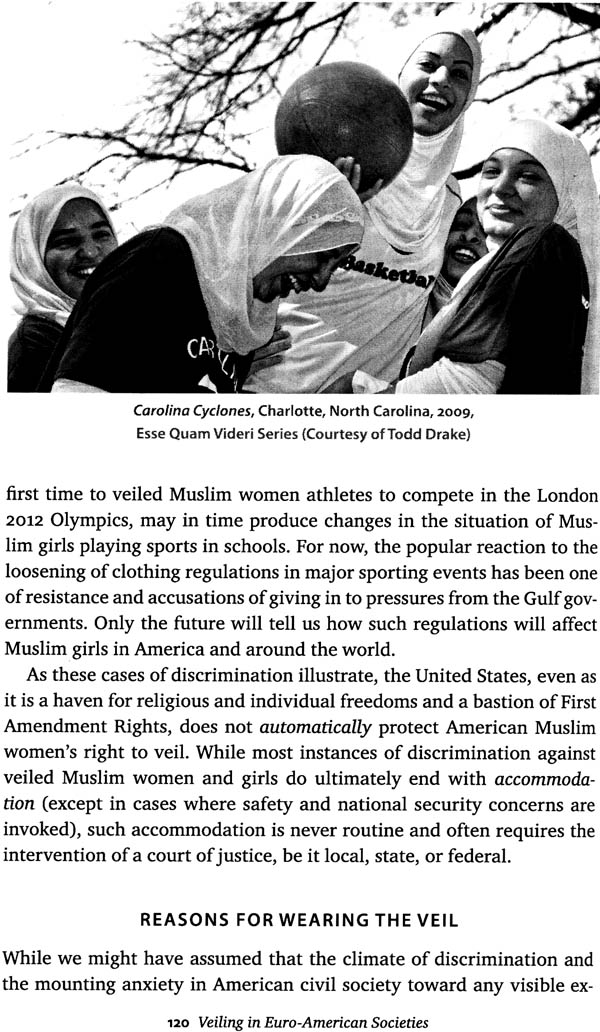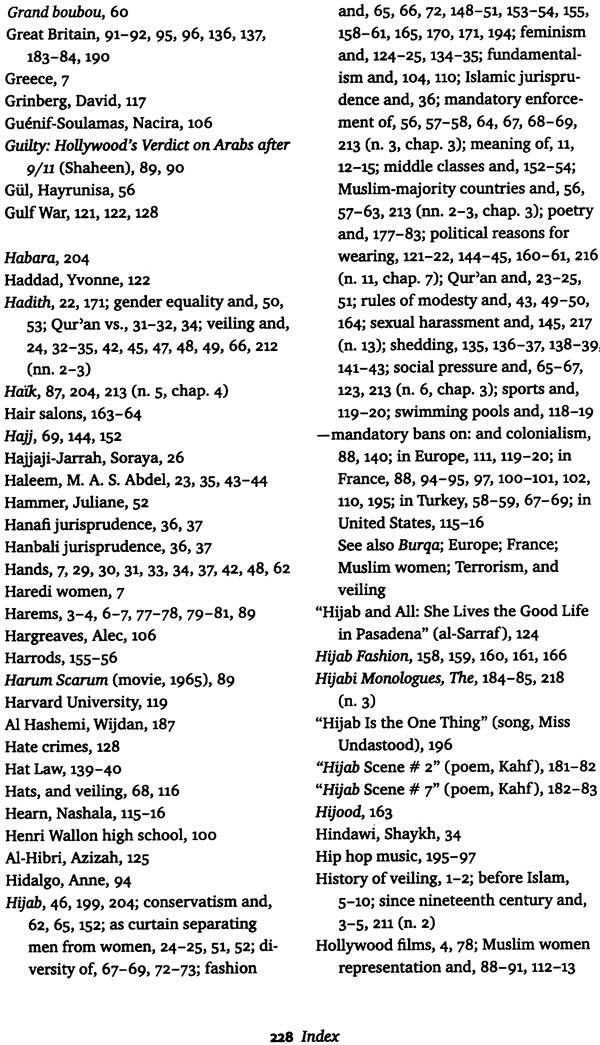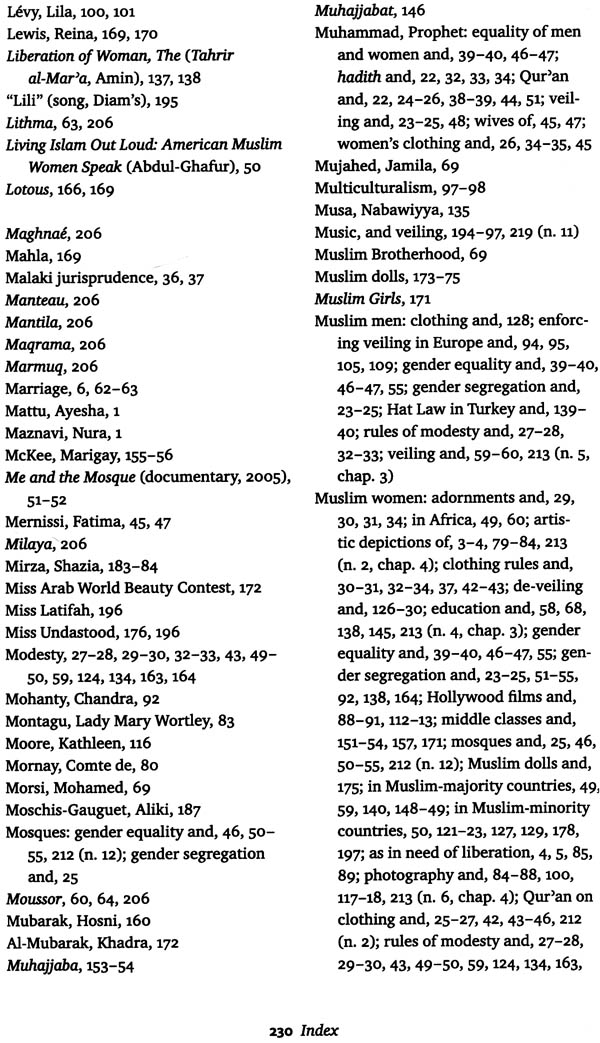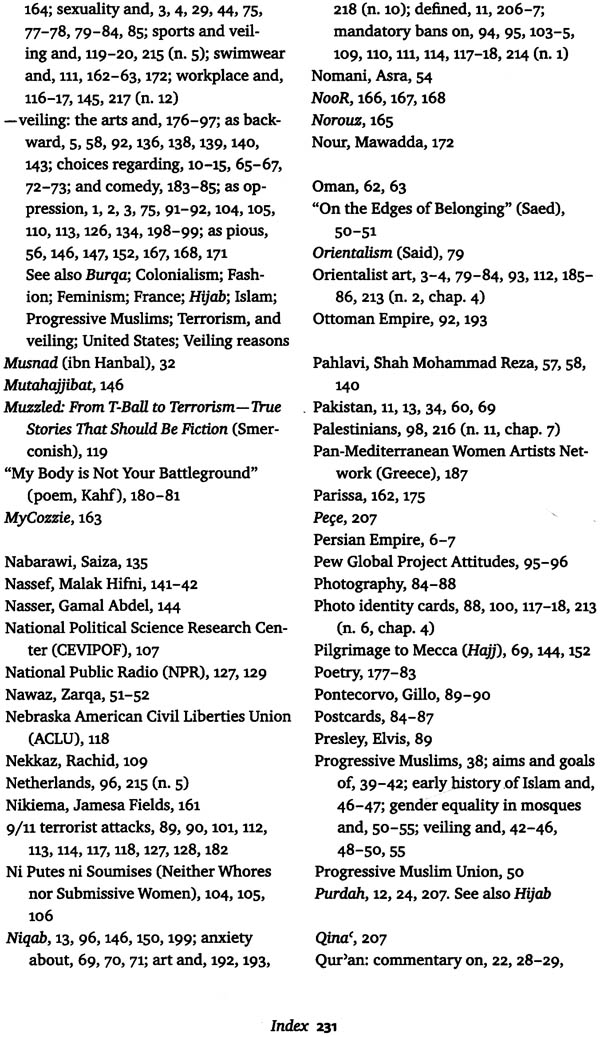
What is Veiling
Book Specification
| Item Code: | NAJ879 |
| Author: | Sahar Amer |
| Publisher: | Dev Publishers and Distributors |
| Language: | English |
| Edition: | 2014 |
| ISBN: | 9789381406403 |
| Pages: | 248 (25 B/W Illustrations & 1 Map) |
| Cover: | Paperback |
| Other Details | 9.0 inch X 6.0 inch |
| Weight | 390 gm |
Book Description
“Veiling is a difficult but timely and important topic. Sahar Amer explains that Muslims didn’t invent the veil, not all Muslims veil the same way, and ideas about Muslim veiling have served and continue to serve political and polemical purposes. A vivid resource for general readers as well as students in course on Islam and women’s studies.”
In this well-written, succinct, and much-needed overview of the role of veiling in the Muslim world, Sahar Amer interweaves the perspectives of Muslim women themselves, with emphasis on the many meanings attached to veiling. Given that veiling has been commonly practiced by many religions, why has the veil become so strongly associated with Islam? Why is it that Muslim women who veil are automatically assumed to be oppressed, ignorant, pious, or militant? How is it that a piece of clothing is so politically and emotionally charged? Amer answers these question clearly over the course of this highly readable book.”
Ranging from simple head scarf to full-body burqa, the veil is worn by vast numbers of Muslim women around the world. What Is Veiling? Explains one of the most visible, controversial, and least understood emblems of Islam. Shar Amer’s evenhanded approach is anchored in sharp cultural insight and rich historical context. Addressing the significance of veiling in the religious, cultural, political, and social lives of Muslims, past and present, she examines the complex role the practice has played in history, religion, conservative and progressive perspective, politics and regionalism, society and economics, feminism, fashion, and art.
By highlighting the multiple meanings of veiling, the book decisively shows the realities of the practice cannot be homogenized or oversimplified and extend well beyond the religious and political accounts that are overwhelmingly proclaimed both inside and outside Muslim-majority societies. Neither defending nor criticizing the practice. What Is Veiling? clarifies the voices of Muslim women who struggle to be heard and who, veiled or not, demand the right to live spiritual, personal, and public lives in dignity.
Islam did not invent veiling, nor is veiling a practice specific to Muslims. Rather, veiling is a tradition that has existed for thousands of years, both in and far beyond the Middle East, and well before Islam came into being in the early seventh century. Throughout history and around the world, veiling has been a custom associated with "women, men, and sacred places, and objects."
Few Muslims and non-Muslims realize that Islam took on veiling practices already in place at the dawn of the seventh century around the Mediterranean 'Basin. Islam inherited them from the major empires and societies of the time along with many other customs and patriarchal traditions related to the status of women. To understand the meaning of veiling in Islam today, one must recognize the important yet neglected history of veiling practices in the pre-Islamic period and appreciate the continuities and similarities among cultures and religious traditions.
Given that veiling has been practiced during the past two millennia by Christian, Jewish, and Muslim women, why does the veil continue to be associated primarily with Muslims, and how did it become one of the most visible signs of Islam as a religion? Why is it that when Muslim women wear a veil, many non-Muslims and some secular Muslims tend to assume that someone coerced these women to dress in that way? Why do many people believe that veiled Muslim women are oppressed, ignorant, extremely pious, or politically militant? Why not view Muslim women in neutral terms, as women who choose or just happen to wear a headscarf? How did this piece of clothing become so emotionally and politically charged for both Muslims and non-Muslims?
My goal in What Is Veiling? is to offer an overview and an appreciation of the complex history and meanings of Muslim veiling. Addressing the questions posed above from the multiple perspectives necessary for understanding veiling will lead us to see that the practice has never had a singular meaning for all Muslims.
Throughout this book, I also aim to give voice to veiled Muslim women and to illuminate the variety of Muslim veiling practices in both Muslim-majority and Muslim-minority societies. I examine the main reasons why so many Muslim women choose to veil today and why others, in a handful of nations and only recently, have been forced to adopt a particular style of dress. Above all, my goal in What Is Veiling? is to show that, even though veiling is one of the most visible signs of Islam, it is also its most debated and least understood practice.
VEILING AND ISLAM
"Veiling" today is not simply a descriptive or neutral term. It is also a judgmental term, especially when associated with Islam. Muslim veiling is a notion that often evokes fear, anxiety, and a rising sense of threat, particularly in the aftermath of 9/11, the onset of the war in Afghanistan, and the 2003 U.S. invasion of Iraq. Veiling is a practice that foments heated debates among ordinary citizens and policy makers in North America and in Europe, as well as in many Muslim-majority societies around the world. It has become a surprisingly powerful symbol.
The veil may symbolize any number of perceived threats. For some, the veil represents the rise of fundamentalist Islam worldwide, a constant reminder of the Iranian Revolution, and the plight of women in Afghanistan. For others, it demonstrates Muslim women's subordination to Muslim men and the impossibility of assimilating Muslim immigrants into Euro-American secular societies. Others still view the veil as a threat to national security, a potential cover-up for suicide bombers, and a troublesome reminder that the world is not safe at the turn of the new millennium. The veil's appearance in most public spaces has been taken as proof that Islam is quintessentially opposed to women's rights. The veil has even come to stand in for the ultimate otherness and inferiority of Islam.
Considering the intensity of the emotions that arise in discussions of veiling, however, the obsession with Muslim women's veiling practices is a relatively recent phenomenon. Only since the nineteenth century has it been an integral part of Euro-American discourses on Islam and the Middle East.
VEILING SINCE THE NINETEENTH CENTURY
Euro-American fascination with the Muslim veil coincided with European military incursions into Muslim-majority societies and with colonial expansions. It was then that the veil first became viewed as a symbol of Muslim women's alleged subordination to Muslim men and as a justification, at least in part, for the Western civilizing mission.
Yet while today many perceive the Muslim veil as a sign of possible militancy and religious extremism, in the nineteenth-century it carried an exotic, erotic connotation.' In colonial literature, arts, music, and films of the period, veiled Muslim women were consistently depicted as available, eager, and acquiescent sexual partners in Western sexual fantasies. They were imagined to be locked up in harems, where they eagerly awaited their rescue from brown men by white men. Rather than protect women's modesty, the veil in effect heightened white men's sexual desire, and thus became more of an erotic accessory than a piece of material culture with a history of its own (see chapter 4).
Liberating veiled Muslim women became a leitmotif of nineteenth- century European discussions about Muslim societies, and a key component of what has come to be known as the White Man's Burden. Some of the same ideas were perpetuated in paintings. Art museums around the world, large and small, boast collections of what has been dubbed "orientalist art," that is, nineteenth-century paintings depicting the way Europeans and Americans imagined Middle Eastern Muslim women. The Louvre in Paris, the Metropolitan Museum of Art in New York City, the more specialized Dahesh Museum of Art in Greenwich, Connecticut, and many university art museums hold important orientalist art collections. In most of these works, Muslim women are seen lounging in luxurious harems, wearing titillating clothes (by nineteenth-century Victorian standards), and looking invitingly toward the viewer. These Muslim women were understood as sexually available, having purpose- fully cast their veils beside them. They were ready to fulfill men's sexual fantasies while also awaiting their rescue by these same European and American men.
During the twentieth century, the Hollywood film industry played a crucial role in perpetuating the image of the harem beauty saved by a Western hero in the image of Rudolph Valentino and in films such as The Sheik (1921) or The Thief of Bagdad (1924). In these movies, women seem to exist only as part of a harem and are consistently portrayed wearing transparent clothes and veils. They also always appear prepared for a sexual encounter or their rescue.
The desire to "save" Muslim women, veiled ones in particular, re- mains a recurring motif in many of today's popular and political debates both in the United States and in Europe. Contemporary Muslim women continue to be viewed as subservient objects to male authority and subject to manipulation by fathers, brothers, and fundamentalist regimes. In this view, contemporary veiled Muslim women too await their liberation by Western forces, who are known today as the spreaders of democracy. Laura Bush famously called for the "liberation" of Afghan women as part of the Bush administration's justification of the American war in Afghanistan.
An obsession with the Muslim veil is not just a Euro-American phenomenon. Muslims themselves, especially in Muslim-majority societies, have also focused on the significance and symbolism of veiled women. At least since the nineteenth century, the sight of unveiled European women had impressed both male and female upper-class Muslims, who were fascinated by European women's status in society, in particular by their good education and by their less pronounced segregation from men. Such elite Muslims came to view the veil as the key symbol of Muslim women's oppression and as the principal stumbling block to their quest for modernity. They thus adopted European views of the veil as they sought to modernize and reform their own societies. By the early twentieth century, unveiling Muslim women and uncovering their heads became the single clearest indicator of modernity in Muslim-majority societies and one of the earliest mandates of Arab feminists (see chapter 7).
In the nineteenth century, and in some secular and liberal circles still today, the Muslim veil is inextricably associated with discussions of development, reform, and progress, and women's garb is the key measure by which to judge a society's modernity. In the first quarter of the twentieth century, modernizing a Muslim-majority society became equivalent to unveiling its women; keeping women veiled was the quintessential sign of a society's backwardness and oppressive mores. Because the very notions and measures of modernity and progress had been first introduced by European colonialists, some Muslims have viewed them with suspicion at times. These Muslims condemned early Arab and Middle Eastern feminists and secularists who had readily assimilated to Western ideas of civilizational worth and progress and called for the unveiling of Muslim women. So while for some Muslims, unveiling Muslim women meant liberation and progress, for others, it meant the exact opposite-the loss of cultural identity and surrender to Western domination. For the latter group, fighting against colonial and neocolonial impositions meant holding onto the veil as a symbol of cultural authenticity, pride, and political resistance.
Of course, veiling is not solely a reaction to Euro-American views. It is also a sign of piety, of obedience to God's mandates, and at times of adherence to a political form of Islam. The new Islamic revival movements that have characterized Middle Eastern societies since the 1980s are also partly responsible for the increase in veiling practices we see today,
The more research I do on veiling, the more I realize that veiling is not and has never been a neutral phenomenon. It has never been simply a personal, religious, or cultural practice. Veiling has always had a multiplicity of competing meanings and motivations at different times and in different places. To fully understand Muslim veiling practices, it is important to take a step back and learn about the larger history of veiling in the world before the establishment of Islam.
| Acknowledgements | ix | |
| Introduction What Is Veiling? | 1 | |
| Part I. | Islam, Politics, And Veiling, | 19 |
| 1 | Understanding Veiling in Islamic Sacred Texts, | 21 |
| 2 | What Do Progressive Muslims Say about Veiling?, | 38 |
| 3 | Politics and Sociocultural Practices of Veiling, | 56 |
| Part II. | Veiling In Euro-American Societies, | 75 |
| 4 | Veils, Harems, and the Mission to Civilize, | 77 |
| 5 | Veiling in Wesern Europe Today, | 94 |
| 6 | Veiling in the United States of America Today, | 112 |
| Part III. | Veiling in The World And Words of Women, | 131 |
| 7 | Veiling and Feminism, | 133 |
| 8 | Islamic Fashion, Beauty Pageants, and Muslim Dolls, | 148 |
| 9 | Veiling through the Arts, | 176 |
| Epilogue, | 198 | |
| Glossary Terms Referring to Veiling, | 201 | |
| Notes, | 211 | |
| Bibliography, | 219 | |
| Index, | 225 |
